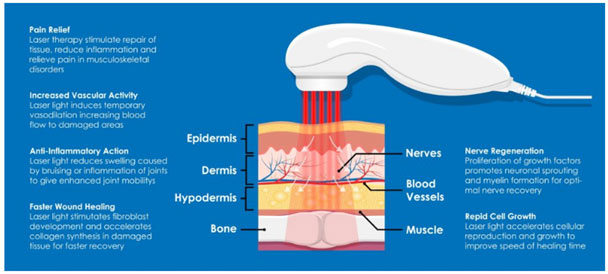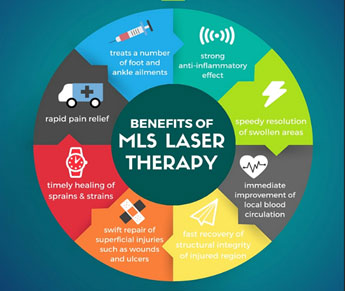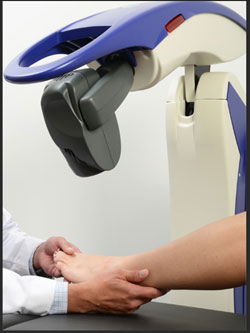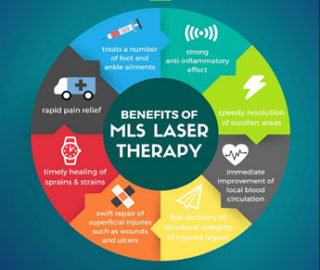Multiwave Locked System (MLS) Laser Pain Therapy


Multiwave Locked System, MLS, laser therapy is provided in office in order to reduce pain, swelling, and inflammation. It is FDA approved and backed up by medical evidence that further proves its effectiveness and no known side effects. The way MLS Laser Therapy works is by using lasers with multiple wavelengths, allowing the practitioner to more accurately direct treatment to the problem spot, even if it is located deeper within the patient’s body or involves a large pained area. Once this light gets into damaged cells, it stimulates inter-cellular activity; it triggers the production of enzymes, stimulation of mitochondria and ATP synthesis; increases vasodilation and lymphatic drainage; and helps in the formation of collagen, preventing the formation of scar tissue. Overall, it stimulates cell repair, tissue healing, and healthy growth of tissues. Benefits of laser therapy includes no lengthy or costly hospital stays, a faster healing rate, and less pain/scarring/swelling. Conditions that laser therapy can treat include, but not limited to, chronic pain conditions, neuropathy, pain in the lower extremities due to numerous causes: fractures/sprains/back or neck injuries/nerve damage; arthritis and inflammation in the joints; heel pain, plantar fasciitis; Achilles tendonitis; post traumatic injury pain; Morton’s neuroma; sports injuries; and more.
What is MLS Laser Therapy? [How Does MLS Laser Therapy Work?]
 How does MLS laser therapy for pain work? MLS laser therapy is an FDA-approved & well-researched treatment for deep pain & neuropathy.
How does MLS laser therapy for pain work? MLS laser therapy is an FDA-approved & well-researched treatment for deep pain & neuropathy.
Look:
- MLS laser therapy is FDA-approved for the treatment of pain.
- Medical research supports its effectiveness in treating many foot & ankle conditions.
Research also supports minimal to no known side effects.
How does MLS laser therapy work?
MLS Laser Therapy has brought about an effective change in the way many challenging pathologies are managed. This is an FDA-approved laser for the treatment of the lower extremity. MLS (multi-wave locked system) technology in specific delivers two therapeutic wavelengths:
- 808nm wavelength (anti-swelling and anti-inflammatory characteristics)
- 905nm wavelength (analgesic characteristics).
Combining these wavelengths produces greater pain-relieving effects than either can produce on their own while also minimizing the risk of thermal damage.
For this reason, it is considered a “cold laser” because it does not burn or hurt the tissue. This unique combination and synchronization of continuous and pulsed emissions characterizes MLS and distinguishes it from other Class IV lasers.
– This powerful, targeted treatment modality delivers anti-inflammatory, anti-swelling, and pain relief.
– Cold laser therapy & class 4 laser therapy has been available for nearly 35 years.
– Recent advances in technology have eliminated previous limitations and maximized effectiveness, yielding exceptional treatment results.
In Summary, here’s what you can expect:
– Quick, painless treatments lasting approximately 10-15 minutes
– No downtime
– 6-10 sessions for full treatment
– Decrease in swelling and pain in as little as 3 treatments
– No side effects
We use laser therapy in our offices because we want to provide an effective and safe treatment option for our patients to heal quickly, recover fully and reduce pain effectively.
MLS laser therapy reviews:
What is MLS Laser Therapy?
– MLS Laser Therapy is painless, with most patients reporting no sensation at all while receiving laser therapy.
– Treatments average 8 minutes.
– MLS Laser Therapy is fast-acting; many patients in high levels of acute pain experience relief after the first or second treatment.
– Over 90% of patients experience positive results after the 3rd treatment, with the average course of treatment being 7 to 10 sessions.
– In many cases, swelling is significantly reduced by the 3rd or 4th treatment, and pain is diminished.
Is it effective for chronic conditions?
The effects of MLS Laser Therapy are cumulative; therefore, improvement is expected throughout treatment. Chronic conditions can be controlled with regular laser therapy treatments.
Is it effective for acute conditions?
Acute conditions usually subside quickly, typically within one phase of treatments. Overall reduction of treatment time through the simultaneous easing of the edema-contracture-pain triad distinguishes MLS Laser Therapy from other laser treatments. All beneficial effects are reciprocally strengthened, delivering timely and targeted results.
What does Multiwave Locked System MLS laser therapy do?
The MLS therapy laser features a synchronized combination of two unique laser emission modes, continuous and pulsed, each delivering their characteristic beneficial effects.
Continuous Laser Emissions:
Continuous laser emissions act quickly on inflammation, stimulating blood and lymphatic circulation and inducing fast re-absorption of fluid build-ups. However, they only have a secondary effect on pain, which is diminished only after reducing the inflammatory process.
Pulsed Laser Emissions:
On the other hand, pulsed laser emissions directly affect pain since they can induce analgesia, interfering with the very transmission of the pain impulse to the higher brain centers. Still, they are less effective at treating inflammation and edema, only achieving results after a lengthy application period.
What makes MLS robotic laser therapy unique?
MLS Laser Therapy is unique in that it organizes continuous and pulsed emissions that generate simultaneous anti-inflammatory and analgesic effects.
Is MLS cold laser therapy FDA approved?
MLS Laser Therapy has been cleared by the FDA and proven successful, as evidenced by extensive and credible studies conducted in our country’s finest institutions, including Harvard University. The MLS laser means a multi-wave locked system laser. It is a particular model of low-level cold laser.
MLS Laser Therapy:
MLS Laser Therapy Indications:
MLS laser therapy is available for the following foot & ankle conditions:
– Arthritic pain.
– Post-surgical swelling.
– Heel pain.
– Plantar fasciitis.
– Achilles tendonitis.
– Traumatic injuries.
– Morton’s neuroma.
– Sports injuries.
– Repetitive motion injuries.
– Sprains & Strains.
– Occupational Injuries.
– Bruising.
– Wounds & Ulcers.
Benefits of Laser Therapy:
–  Rapid relief of pain.
Rapid relief of pain.
– Strong anti-inflammatory effect.
– Timely healing of sprains and strains.
– Faster recovery of the structural integrity of the injured region.
– Prompt resolution of swollen areas.
– Immediate improvement of local blood circulation.
– Rapid repair of superficial injuries, such as wounds and ulcers.
Does the MLS laser have side effects?
MLS Laser Therapy has no known adverse side effects, a non-invasive, non-pharmacological solution for even the most complex cases. This is a difficult claim to make, but this is backed by scientific research.
MRI validation of laser treatment of plantar fasciitis:
This 2017 study found that shockwave therapy and low-level laser therapy were significantly superior to ultrasound therapy. They found that after 1 month, the pain score had improved, and almost all patients by at least 2 out of 10.
It also found that the success rate was 70.6% in the laser group, 65% in the shockwave group, and just 23% in the ultrasound therapy group. For this reason, we believe MLS laser therapy and shockwave therapy are much more beneficial than just ultrasound therapy.
Research Studies for MLS laser treatment:
MLS laser therapy for Achilles tendonitis:
This 2021 study aims to compare low-level laser therapy for Achilles tendonitis.
The studies we had mentioned earlier have proven to be very beneficial in improving the pain, function, and elasticity regarding connective tissue such as the plantar fascia. There have been no specific high-level studies aimed at Achilles tendinitis. But there is a study regarding a low-level laser therapy for Achilles Tendonitis Currently taking place in Lithuania. We are eagerly awaiting the results, and we anticipate that this will be a high outcome study.
MLS laser therapy for arthritis
This 2015 study looked at knee osteoarthritis with low-level laser therapy. It looked at 612 studies, including 9 randomized controlled trials. It did find a very slight improvement with laser therapy, but it appears that laser therapy does not affect healing knee arthritis. There are 2 things to consider:
#1 is that laser is more effective for connective tissue and soft tissue injuries.
#2 since 2015, there has been a lot of improvements regarding low-level laser therapy, including the dual wave capabilities of MLS laser therapy.
In our opinion, it is unlikely that laser therapy can cure osteoarthritis, nor does it claim to. Laser therapy can likely reduce inflammation and increased metabolism in the area. Unfortunately, the body does not have the ability to self-heal osteoarthritis.
MLS laser therapy for feet:
The MLS laser has been proven to be scientifically validated for numerous foot and ankle pain conditions. Specifically, it is effective in most proven plantar fasciitis, Achilles tendonitis, soft tissue skin conditions, foot and ankle pain secondary to peripheral neuropathy.
MLS laser therapy for Morton’s neuroma:
This 2017 study shows the effectiveness of low High-intensity laser therapy and then testing with diagnostic ultrasound. This retrospective ultrasound review of 31 pretreatment Morton neuroma feet showed neuroma changes in 30 out of 31 cases. After using low-level laser therapy, 29 out of 31 cases had shown decreased pain or changes through the neuroma site. Although this is not a direct comparison of an MLS laser for Morton’s neuroma treatment, there is some overlap between high-intensity laser therapy and MLS laser therapy that uses a multi-wave locked system.
Low-level laser therapy for peripheral neuropathy:
This 2019 study looked back at 627 research papers. These ranged from both low-level studies and high-level studies. This retrospective analysis aimed to determine if low-level laser therapy was an effective treatment for peripheral neuropathy in the feet and neuropathic foot pain. It is determined that low-level laser therapy works by triggering biomechanical changes within cells.
This retrospective study concluded that low-level laser therapy and cold laser therapy had a very positive effect in controlling diabetic neuropathic pain and peripheral neuropathy in patients with diabetes.
Cold laser therapy for diabetic neuropathy:
A cold laser is another name for low-level laser therapy. MLS multi-wave locked system is a type of low laser therapy. This 2019 study looked back at 627 research papers. The goal was to determine how effective a cold laser was in treating diabetic peripheral neuropathy. This retrospective study concluded that low-level laser therapy and cold laser therapy had a very positive effect in controlling diabetic neuropathic pain and peripheral neuropathy in patients with diabetes.
Does laser therapy help peripheral neuropathy?
One of the more common questions patients ask us is, “does laser therapy help neuropathy?” As time goes on and laser therapy improves, that answer is a resounding YES. There are now many studies regarding cold laser therapy and peripheral neuropathy treatment proving how effective the cold laser can be. At our clinic, we utilize the MLS laser therapy system. This is considered an advanced multi-wave blocked system that utilizes various bands of laser therapy to affect changes in cell structure. Laser therapy is FDA-approved for foot and ankle conditions, but unfortunately, it is not always covered by insurance. We believe that the cost is reasonable and arrivals the standard co-pay of what most patients would pay for an insurance plan anyway.
Cold laser therapy for chemo-induced neuropathy:
This 2018 study was designed to evaluate the treatment of chemotherapy-induced peripheral neuropathy. This paper did look at 26 different treatment options within 35 studies when looking back on treating chemotherapy-induced peripheral neuropathy. This review article did note that low-level laser therapy is considered to be of moderate evidence based on evidence review. The literature does know that medications were also the most successful treatment options and were on part as moderate level evidence. Other forms of treatment were noted to be of lower-level treatment evidence for chemotherapy-induced peripheral neuropathy.
Low-level laser treatment for peripheral neuropathy:
This 2018 study looks at medication versus low-level laser therapy and cold laser therapy treatment of peripheral neuropathy. This study confirmed that cold laser therapy and low-level laser treatment effectively improved peripheral neuropathy and cellular markers within the nerves. The authors further concluded that cold laser therapy was a much more effective option in treating peripheral neuropathy as it is a non-invasive treatment option.
MLS laser therapy research:
It is known that specific light emissions can transfer energy to cells and tissue essentially. Upon exposure to laser light, areas subject to poor metabolism recover total activity. However, some light emissions are more effective than others. MLS laser therapy attempts to combine the most effective light emissions for tissue stimulation and healing.
MLS class 4 laser therapy:
 Cold laser therapy (class 4 level laser)
Cold laser therapy (class 4 level laser)
How does MLS laser therapy work?
Thanks to identifying an extremely efficient waveform, the MLS Laser wavelengths attempt to provide the most profound possible action. This is based on scientific findings on the capacity of coherent light to penetrate biological tissues (epidermis, dermis, and subcutaneous tissue).The depth reached by light emissions depends on the incidental radiation wavelength. The reason lies in the presence of specific superficial chromophores that present areas of maximum absorption in correspondence to particular wavelength intervals. These wavelengths will therefore be filtered and not reach the deepest tissue layers and transparent in other areas of the electromagnetic spectrum.
The interval between 600 and 1200 nm is known as the ‘therapeutic window’ because there are no chromophores in this range to filter the light emission. The wavelengths of the emissions making up the MLS pulse fall into this precise interval, meaning that they can reach the deepest anatomical structures that are often involved in ailments that MLS Therapy is most suitable for treating. Other wavelengths do not have the same effect. The MLS emission can wholly and quickly restore an optimal biochemical and bioelectrical balance utilizing efficient energy transfer. The use of the MLS Laser makes it possible to recruit intracellular photoreceptors immediately and restore higher energy conditions to the cells.
MLS laser therapy for plantar fasciitis reviews:
This 2018 study found that both shockwave therapy and laser therapy were very effective for plantar fasciitis. This research paper found excellent results at 6 weeks and 12 weeks following therapy. On a visual analog scale ranging from 0-10, there is an average reduction of 6.6 out of 10 on the pain scale.This is an excellent outcome. This was a high-level study looking at 1676 patients with plantar fasciitis.These studies did compare to other treatment options such as a placebo, neurostimulation, eccentric muscle strengthening.This is a very high-level study with a high amount of patients showing excellent results. On average, it is rare to improve 6.6 out of 10 in any treatment program.These plantar fasciitis reviews correlate with our experiences which show excellent overall improvement.This study confirms that MLS laser therapy for plantar fasciitis is very effective for foot pain, Achilles tendinitis, and others.
Cold laser & shockwave therapy on plantar fasciitis studies:
This 2020 scientific research study looked at the effective high-intensity laser therapy versus low-level laser therapy in treating plantar fasciitis.MLS laser therapy was not specifically studied in this research paper, but MLS treatment does combine different wavelengths similar to these types of laser assistance.
This was a randomized participant blind controlled trial.This study found that both high-intensity laser and low-intensity laser were very effective in treating plantar fasciitis. In just 3 weeks, the patient had experienced a 2.57 out of 10 pain relief score versus a 2.88 visual analog scale out of 10 improvements. These are both excellent results for only 3 weeks of treatment.This study determined that laser therapy also is very effective in treating plantar fasciitis.
MRI validation of laser treatment of plantar fasciitis:
This 2017 study found that shockwave therapy and low-level laser therapy were significantly superior to ultrasound therapy.They found that after 1 month, the pain score had improved, and almost all patients by at least 2 out of 10.
It also found that the success rate was 70.6% in the laser group, 65% in the shockwave group, and just 23% in the ultrasound therapy group.For this reason, we believe MLS laser therapy and shockwave therapy are much more beneficial than just ultrasound therapy.
Research Studies for MLS laser treatment:
MLS laser therapy for Achilles tendonitis:
This 2021 study aims to compare low-level laser therapy for Achilles tendonitis.
The studies we had mentioned earlier have proven to be very beneficial in improving the pain, function, and elasticity regarding connective tissue such as the plantar fascia.There have been no specific high-level studies aimed at Achilles tendinitis. But there is a study regarding a low-level laser therapy for Achilles Tendonitis Currently taking place in Lithuania.We are eagerly awaiting the results, and we anticipate that this will be a high outcome study.
MLS laser therapy for arthritis
This 2015 study looked at knee osteoarthritis with low-level laser therapy. It looked at 612 studies, including 9 randomized controlled trials. It did find a very slight improvement with laser therapy, but it appears that laser therapy does not affect healing knee arthritis.There are 2 things to consider:
#1 is that laser is more effective for connective tissue and soft tissue injuries.
#2 since 2015, there has been a lot of improvements regarding low-level laser therapy, including the dual wave capabilities of MLS laser therapy.
In our opinion, it is unlikely that laser therapy can cure osteoarthritis, nor does it claim to. Laser therapy can likely reduce inflammation and increased metabolism in the area. Unfortunately, the body does not have the ability to self-heal osteoarthritis.
MLS laser therapy for feet:
The MLS laser has been proven to be scientifically validated for numerous foot and ankle pain conditions.Specifically, it is effective in most proven plantar fasciitis, Achilles tendonitis, soft tissue skin conditions, foot and ankle pain secondary to peripheral neuropathy.
MLS laser therapy for Morton’s neuroma:
This 2017 study shows the effectiveness of low High-intensity laser therapy and then testing with diagnostic ultrasound.This retrospective ultrasound review of 31 pretreatment Morton neuroma feet showed neuroma changes in 30 out of 31 cases.After using low-level laser therapy, 29 out of 31 cases had shown decreased pain or changes through the neuroma site. Although this is not a direct comparison of an MLS laser for Morton’s neuroma treatment, there is some overlap between high-intensity laser therapy and MLS laser therapy that uses a multi-wave locked system.
Research Studies for MLS laser treatment:
MLS laser therapy for Achilles tendonitis:
This 2021 study aims to compare low-level laser therapy for Achilles tendonitis.
The studies we had mentioned earlier have proven to be very beneficial in improving the pain, function, and elasticity regarding connective tissue such as the plantar fascia.There have been no specific high-level studies aimed at Achilles tendinitis. But there is a study regarding a low-level laser therapy for Achilles Tendonitis Currently taking place in Lithuania.We are eagerly awaiting the results, and we anticipate that this will be a high outcome study.
MLS laser therapy for arthritis
This 2015 study looked at knee osteoarthritis with low-level laser therapy. It looked at 612 studies, including 9 randomized controlled trials. It did find a very slight improvement with laser therapy, but it appears that laser therapy does not affect healing knee arthritis.There are 2 things to consider:
#1 is that laser is more effective for connective tissue and soft tissue injuries.
#2 since 2015, there has been a lot of improvements regarding low-level laser therapy, including the dual wave capabilities of MLS laser therapy.
In our opinion, it is unlikely that laser therapy can cure osteoarthritis, nor does it claim to. Laser therapy can likely reduce inflammation and increased metabolism in the area. Unfortunately, the body does not have the ability to self-heal osteoarthritis.
MLS laser therapy for feet:
The MLS laser has been proven to be scientifically validated for numerous foot and ankle pain conditions.Specifically, it is effective in most proven plantar fasciitis, Achilles tendonitis, soft tissue skin conditions, foot and ankle pain secondary to peripheral neuropathy.
MLS laser therapy for Morton’s neuroma:
This 2017 study shows the effectiveness of low High-intensity laser therapy and then testing with diagnostic ultrasound.This retrospective ultrasound review of 31 pretreatment Morton neuroma feet showed neuroma changes in 30 out of 31 cases.After using low-level laser therapy, 29 out of 31 cases had shown decreased pain or changes through the neuroma site. Although this is not a direct comparison of an MLS laser for Morton’s neuroma treatment, there is some overlap between high-intensity laser therapy and MLS laser therapy that uses a multi-wave locked system.
Frequently Asked Questions:
Is MLS therapy effective on neuropathic pain?
This study tested laser therapy on rats with induced nerve damage. This scientific paper found that the protective sheath called the myelin sheath around the nerves was able to show signs of regeneration. It did show beneficial chemical changes. This study states that there is very positive support for laser therapy as a strategy for patients suffering from neuropathic pain.
Does MLS laser therapy help with tendinopathy?
This study was a small study that looked at 6 adult sheep with induced tendon lesions. It measured how 10 treatments of MLS laser therapy resulted in tendon improvement. This study found that laser therapy on sheep with induced tendon injuries did show an anti-inflammatory effect. It did show that there is less inflammation and increased collagen fiber organization in the tendons. In summary, this means an improvement in blood supply and increased tendon reorganization and healing.
